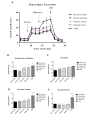Enhanced bioenergetic cellular activity with metabolic switch to aerobic glycolysis in Keloid and Folliculitis Keloidalis Nuchae
- PMID: 38878082
- PMCID: PMC11180017
- DOI: 10.1007/s00403-024-03038-5
Enhanced bioenergetic cellular activity with metabolic switch to aerobic glycolysis in Keloid and Folliculitis Keloidalis Nuchae
Abstract
Keloid scars and folliculitis keloidalis nuchae (FKN) are benign fibroproliferative dermal lesions of unknown aetiology and ill-defined treatment, which typically present in genetically susceptible individuals. Their pathognomonic hallmarks include local aggressive invasive behaviour plus high recurrence post-therapy. In view of this, we investigated proliferative and key parameters of bioenergetic cellular characteristics of site-specific keloid-derived fibroblasts (intra(centre)- and peri(margin)-lesional) and FKN compared to normal skin and normal flat non-hypertrophic scar fibroblasts as negative controls.The results showed statistically significant (P < 0.01) and variable growth dynamics with increased proliferation and migration in keloid fibroblasts, while FKN fibroblasts showed a significant (P < 0.001) increase in proliferation but similar migration profile to controls. A statistically significant metabolic switch towards aerobic glycolysis in the fibroblasts from the disease conditions was noted. Furthermore, an increase in basal glycolysis with a concomitant increase in the cellular maximum glycolytic capacity was also demonstrated in perilesional keloid and FKN fibroblasts (P < 0.05). Mitochondrial function parameters showed increased oxidative phosphorylation in the disease conditions (P < 0.05) indicating functional mitochondria. These findings further suggest that Keloids and FKN demonstrate a switch to a metabolic phenotype of aerobic glycolysis. Increased glycolytic flux inhibition is a potential mechanistic basis for future therapy.
Keywords: Cell bioenergetics; Folliculitis Keloidalis Nuchea; Glycolysis; Keloid; Metabolism; Scarring.
© 2024. The Author(s).
Conflict of interest statement
The authors have no conflicts of interest to declare.
Figures







Similar articles
-
Metabolic reprogramming in keloid fibroblasts: Aerobic glycolysis and a novel therapeutic strategy.Biochem Biophys Res Commun. 2018 Feb 5;496(2):641-647. doi: 10.1016/j.bbrc.2018.01.068. Epub 2018 Jan 11. Biochem Biophys Res Commun. 2018. PMID: 29337061
-
NEDD4L Inhibits the Proliferation and Migration of Keloid Fibroblasts by Regulating YY1 Ubiquitination-Mediated Glycolytic Metabolic Reprogramming.Exp Dermatol. 2024 Nov;33(11):e70008. doi: 10.1111/exd.70008. Exp Dermatol. 2024. PMID: 39494931
-
Increased expression of fibroblast activation protein-alpha in keloid fibroblasts: implications for development of a novel treatment option.Arch Dermatol Res. 2010 Dec;302(10):725-31. doi: 10.1007/s00403-010-1084-x. Epub 2010 Sep 26. Arch Dermatol Res. 2010. PMID: 20872224
-
Immune cells and associated molecular markers in dermal fibrosis with focus on raised cutaneous scars.Exp Dermatol. 2023 May;32(5):570-587. doi: 10.1111/exd.14734. Epub 2023 Feb 20. Exp Dermatol. 2023. PMID: 36562321 Free PMC article. Review.
-
Keloid and Hypertrophic Scars Are the Result of Chronic Inflammation in the Reticular Dermis.Int J Mol Sci. 2017 Mar 10;18(3):606. doi: 10.3390/ijms18030606. Int J Mol Sci. 2017. PMID: 28287424 Free PMC article. Review.
Cited by
-
Keratin-Mediated Selective Inhibition in Proliferation and Selective Apoptosis of Keloid Fibroblasts.Biomater Res. 2025 Jul 22;29:0231. doi: 10.34133/bmr.0231. eCollection 2025. Biomater Res. 2025. PMID: 40697649 Free PMC article.
References
-
- Mari W, Alsabri SG, Tabal N, Younes S, Sherif A, Simman R Novel Insights on Understanding of Keloid Scar: Article Review. J Am Coll Clin Wound Spec [Internet]. 2015 Dec 1 [cited 2019 Jun 27];7(1–3):1–7. https://www.sciencedirect.com/science/article/abs/pii/S2213510316300379 - PMC - PubMed
-
- Ud-Din S, Bayat A (2013) Strategic management of keloid disease in ethnic skin: a structured approach supported by the emerging literature. Br J Dermatol [Internet]. Oct [cited 2019 Jun 28];169:71–81. 10.1111/bjd.12588 - PubMed
MeSH terms
LinkOut - more resources
Full Text Sources
Research Materials
Miscellaneous

